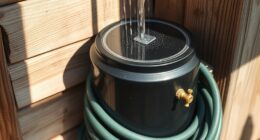The first step in building a rope ladder for a treehouse is to securely fasten it to the tree. It is important to attach it in a way that prevents the rope from tearing while children use it. After it is securely attached, you can start climbing. It is recommended to climb one person at a time to ensure even weight distribution. Once the security of the rope ladder is confirmed, you can then add safety equipment for your child.
Tie a Marlin Spike Hitch to A Rope Ladder
A Marlin Spike Hitch is used to attach wooden rungs to the ropes. It can be tied in two ways: one way involves pulling the standing part of the rope through and the other way involves sticking the rung into the new loop. To tie a rope ladder, it is recommended to start at the top of the ladder and work downwards. For a shorter ladder, you can tie on the rungs vertically, while for a longer one, you must start at the ground.
Before tying a rope ladder for tree house, make sure it is even on both sides. This will prevent uneven rope stress on the rungs. If you don’t want your children to climb the ladder, it is important to have even ropes on both sides. Also, make sure you use round wood rungs. Once the ladder is tied, it’s time to install brackets to hang the rope ladder.
A Marlinspike Hitch is a popular knot for building a rope ladder. It is a middle knot that is strong enough to hold small objects. Originally, boatsmen used this knot to hold onto big nails called marlinespikes. The knot is useful for making temporary ladders, as it makes it easier to yank a rope.
For a simple rope ladder, the marlinspike hitch is a great option. It is easy to tie and doesn’t jam up when a load is applied. Also, it is ideal for long-term use. A marlinspike hitch can be tied around a bar or pole, or even a thick dowel. If you’re rigging a tree house for your child, you can also attach a whoopie sling to the end of the rope.
Strength of Rope
The strength of a rope ladder is an important factor when building a tree house. You want to make sure that each rung is tight. This might take some practice. Once you have mastered the process, you can store the ladder in your shed. You can then use it again later for another project. The next time you want to build a rope ladder for your tree house, consider these tips:
The first thing to remember is that climbing rope is a safety hazard. You should check its strength regularly. It is also advisable to install a wall or railing at the landing of the tree house. This will help prevent young kids from using it. Besides, it will be easier to demonstrate the use of a rope ladder if two ropes are used. You can also make it easier to explain by using different colors for the ropes.
To make sure the ladder is safe, you should use anchors or carabiners to attach the top rungs. Heavy duty anchors are highly recommended because they can withstand a lot of weight. Stainless steel equipment is also recommended since it can withstand tough weather conditions. The platform and overhead beam should be attached to the ladder’s anchors. If the ladder is made with rope, be sure to use locking carabiners to secure it. Once it is secured, you can attach it to an anchor with a wrench.
Another factor to consider is the strength of the rope. The rope must be strong enough to safely transmit tensile force into the tree. A common way to tie the rope is to use eye bolts. The eye bolts will prevent the cables from coming untied when under load. Make sure that you tie the cables in a way that prevents damage to the tree. Also, make sure that you have backup cables in case the ropes break.
Durability of Rope
When choosing a rope ladder for your child’s tree house, the first thing to consider is its durability. Ropes can be brittle and prone to breaking, but a good-quality rope ladder is more durable. It should be taut, with a slight angle to the vertical. Having a taut bottom is a great feature, as it will make climbing easier. Another great feature of a rope ladder is that it features sturdy rungs made of durable plastic. A sturdy rope ladder can support up to 176 pounds of weight, which is a great feature, as it ensures safe play for children. Plastic climbing ladders are also easier to clean and feature attractive, three-color designs.
There are two types of rope ladders available: the “Drilled Step” and “Tied Step.” A Drilled Step is more durable and requires a little more work to create. This type is heavier than a “Tied” version. While a Drilled Step rope ladder can be durable, it is best to tie it down securely to avoid hitting objects or people. Another type of rope ladder is the “Tied” type, which is more lightweight and easy to assemble. These are great for kids, as they can easily be inspected to ensure that they are sturdy and safe. A Drilled Step rope ladder also requires a bottom fixed to the ground, preventing it from falling.
To tie the rungs securely, use a marlin spike hitch. This knot is easy to tie but takes 40 minutes. Another type of knot is the constrictor knot, which is more durable and will not work loose if the ladder isn’t under load. You can also measure the lengths of the rungs with a pencil and tape. Using the tape, measure the distance between each rung and mark the holes where the rope will be tied.
Safety of A Rope Ladder
Rope ladders are a great addition to any tree house and provide children with a fun and safe place to play. While you should make sure the tree house has strong support for the ladder, it is best to secure it to the ground from the top. Anchors or carabiners are good options. Make sure you choose heavy-duty ones that will support a lot of weight. Choose stainless steel equipment, since it will stand up to the elements. You should also ensure that the platform and overhead beam are secure. Be sure to tighten the anchors with a wrench.
A rope ladder is also useful when climbing trees. It should be sturdy and slightly angled off vertical, as the weight of the climber will swing underneath it. If the ladder has pegs, make sure the pegs are flush with the ground. You can cover the pegs with soft material to prevent slipping. It is important to have a ladder that is safe for kids of all ages and is suited to the area you’re building.
Another advantage of a rope ladder is that it is lightweight, making climbing easier for children. However, you’ll need to learn how to properly use the ladder and distribute your weight evenly. Rope ladders for children are typically made of durable synthetic hemp that’s soft to the touch. They also feature hardwood rungs that are strong and safe. A rope ladder is perfect for climbing up a tree house.
When making a rope ladder for your child’s tree house, you should use high-quality materials. If the rope ladder is not made of suitable wood, it may be unsafe and can even cause injury to your child. If you buy a defective rope ladder, it may be possible to hold the manufacturer and distributor responsible for any injuries or deaths caused by the product. However, the manufacturer may have been negligent in making the ladders and failing to warn consumers of the risks.
Types of Rope
There are many types of rope ladder for a tree house. Some are built vertically, while others are horizontal. Both types of rope ladders can be built in a few hours. They are best tied with marlin spike hitches. These are a great knot for vertical weight and can be used for pulling and securing. They are also very easy to make. After figuring out which one to use, you’ll want to tie it securely to the overhead beam or platform.
There are two main types of rope ladder for tree houses. The rung style uses two ropes – one that is folded in half, and another one that is started from the middle. The two ropes are usually different colours, as this makes it easier to demonstrate which one is which. You may also want to use a ladder with multiple rungs to make climbing easier. A single rung ladder can be built up to 8 feet tall, but a double-rung rope ladder is the best choice for smaller trees.
Another type of rope ladder is the Tied Rope Ladder. It uses a thinner rope than the other two. The thinner rope makes it easier to tie a Marlin Spike Hitch, and thicker rope may look a bit odd. An 8mm braded polyester rope is strong enough to be used outside, but a thicker rope can cause the ladder to break easily. This method is best for a tree house where it won’t be in direct sunlight.
Rope ladders can also be used in other situations besides tree houses. They’re common on boats at sea and in emergency situations such as a fire. They can be used to access high locations without any complicated equipment. Some rope ladders are also used in rock climbing, where they’re used for scaling areas without handholds. There are many different kinds of rope ladders, and the best one for your needs depends on your needs and budget.
I’m Theodore, and I love tiny houses. In fact, I’m the author of Tiny House 43, a book about tiny houses that are also tree houses. I think they’re magical places where imaginations can run wild and adventures are just waiting to happen.
While tree houses are often associated with childhood, they can be the perfect adult retreat. They offer a cozy space to relax and unwind, surrounded by nature. And since they’re typically built on stilts or raised platforms, they offer stunning views that traditional homes simply can’t match.
If you’re looking for a unique and romantic getaway, a tree house tiny house might just be the perfect option.











